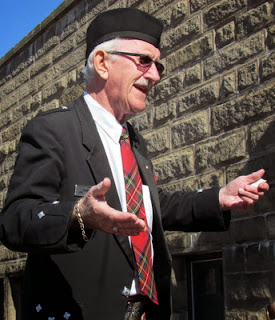The first “sight” was the beach at the
harbor…remarkable, according to Jim the Guide, because people are able to swim
in this huge harbor because the water is so clean.
He pointed out that these trees are growing out of
the rocks because there is little topsoil in the area.
Also, a hurricane went through Halifax about 10
years ago and destroyed thousands of trees. We saw a couple of sculptures in
people’s yards which had been carved from the stumps of downed trees. This one
depicts three eagles.
We then drove through a neighborhood of elegant
houses, circled a lovely Victorian style park, and saw many medical
buildings. Are you beginning to see that
there isn’t that much to the historic heart of Halifax?
However, there are two main historic sites. The first is the Halifax Citadel.
With the founding of Halifax in 1749, the first of four forts was constructed on this drumlin high above the original town. This aerial view shows its strategic vantage point.
With the founding of Halifax in 1749, the first of four forts was constructed on this drumlin high above the original town. This aerial view shows its strategic vantage point.
The Citadel has a long and intricate history
through the French Revolution, Napoleonic Wars, War of 1812, even WWI and WWII
where it served as transit barracks and an anti-aircraft command center.
Inside the fort stands The Cavalier Building in
the center of the parade grounds. Once barracks, it now houses the information
center, a gift shop, café, and museum.
We were there to see the changing of the guard.
From the viewing platforms, you can see the Old
Town Clock which is one of the most recognizable landmarks of historic
Halifax. This garrison clock began
keeping time on October 20, 1803. You
might know that the clock faces are different sizes. Don’t know why.
From the Citadel, we went to the other noted Halifax historic place, the Fairlawn Cemetery, which has a link to the sinking of the Titanic. Two days after the Titanic sank in 1912, the White Star Line dispatched the first of four Canadian vessels to search for bodies. Two of these vessels were based in Halifax.
From the Citadel, we went to the other noted Halifax historic place, the Fairlawn Cemetery, which has a link to the sinking of the Titanic. Two days after the Titanic sank in 1912, the White Star Line dispatched the first of four Canadian vessels to search for bodies. Two of these vessels were based in Halifax.
One of these ships recovered 306 bodies from the
water. Some of these were buried at sea,
but 209 were brought back and unloaded at the Dockyard at Halifax.

Only 59 bodies were shipped out by train to their
families. The remaining victims were
buried in three cemeteries in Halifax, Fairlawn, a Jewish cemetery, and a
Catholic cemetery.
Most of the gravestones, erected in the fall of
1912, were paid for by the White Star Line and are plain granite blocks.















Great sights and history, but I kinda like the pink double-decker bus the best!
ReplyDelete